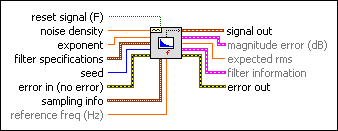 |
reset signal resets the noise sample generator and the time stamp to zero. The default is FALSE.
|
 |
noise density specifies the spectral density (V/root Hz) of the ideal inverse-f noise waveform at the frequency reference freq. The actual inverse-f noise waveform approximates the ideal inverse-f noise over the frequency range defined by filter specifications. Therefore, the actual spectral density of the inverse-f noise waveform at reference freq is near noise density only if reference freq is within the design frequency range specified in filter specifications.
|
 |
exponent specifies the exponent of the desired inverse-f noise spectral shape. This VI generates the inverse-f noise waveform by passing white noise through a digital filter with a desired magnitude-squared response of 1/frequency^exponent.
|
 |
filter specifications specifies the operating frequency range and the filter order of the filter.
 |
lower cutoff freq specifies the lower frequency edge of the operating frequency range of the filter.
|
 |
higher cutoff freq specifies the higher frequency edge of the operating frequency range of the filter.
|
 |
order specifies the number of first order stages of the inverse-f filter. Increasing order improves the inverse-f spectral shape but requires more computation time during filter operation.
|
|
 |
seed, when greater than 0, causes reseeding of the noise sample generator. The default is –1. LabVIEW maintains the internal seed state independently for each instance of this reentrant VI. For a specific instance of this VI, if seed is less than or equal to 0, LabVIEW does not reseed the noise generator, and the noise generator resumes producing noise samples as a continuation of the previous noise sequence.
|
 |
error in describes error conditions that occur before this node runs. With the following exception, this input provides standard error in functionality.
This node runs normally even if an error occurred before this node runs.
|
 |
sampling info contains sampling information.
 |
Fs is the sampling rate in samples per second. The default is 1000.
|
 |
#s is the number of samples in the waveform. The default is 1000.
|
|
 |
reference freq specifies the frequency in Hz at which the spectral density of the ideal inverse-f noise waveform is equal to noise density. The actual inverse-f noise waveform source is designed to approximate the ideal inverse-f noise waveform over the frequency range defined in filter specifications. Therefore, the actual spectral density of the inverse-f noise waveform at reference freq is near noise density if reference freq is within the design frequency range specified in filter specifications.
|
 |
signal out returns the generated inverse-f noise waveform.
|
 |
magnitude error returns the magnitude of the deviation of the actual inverse-f filter in dB when measured against the ideal inverse-f filter. The ideal filter has a magnitude-squared response proportional to 1/f exponent over the frequency range specified by filter specifications.
 |
frequency returns the frequencies of the magnitude error in Hz.
|
 |
magnitude returns the magnitudes of the magnitude error in dB.
|
|
 |
expected rms returns the expected RMS level of the generated noise waveform.
|
 |
filter information returns the magnitude and phase of the frequency response of the designed inverse-f filter.
 |
magnitude returns the magnitude of the frequency response of the designed inverse-f filter in dB.
 |
frequency returns the frequencies of the frequency response of the designed inverse-f filter in Hz.
|
 |
magnitude returns the magnitudes of the frequency response of the designed inverse-f filter in dB.
|
|
 |
phase returns the phase of the frequency response of the designed inverse-f filter in degrees.
 |
frequency returns the frequencies of the frequency response of the designed inverse-f filter in Hz.
|
 |
phase returns the phases of the frequency response of the designed inverse-f filter in degrees.
|
|
|
 |
error out contains error information. This output provides standard error out functionality.
|
This VI generates the inverse-f noise waveform by passing spectrally flat, or white, noise through a digital filter with a desired magnitude-squared response of 1/frequency^exponent.

 Add to the block diagram
Add to the block diagram Find on the palette
Find on the palette








